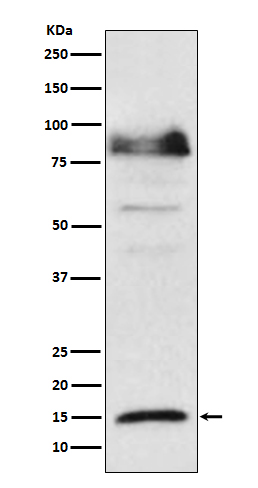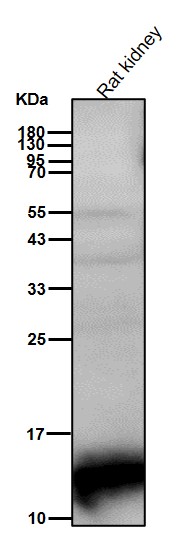

| WB | 咨询技术 | Human,Mouse,Rat |
| IF | 咨询技术 | Human,Mouse,Rat |
| IHC | IHC:1/100-1/200;IHF:1/50-1/200 | Human,Mouse,Rat |
| ICC | 1/50-1/200 | Human,Mouse,Rat |
| FCM | 咨询技术 | Human,Mouse,Rat |
| Elisa | 咨询技术 | Human,Mouse,Rat |
| Aliases | IP17; Ubiquitin cross-reactive protein; hUCRP; ISG15; G1P2;;ISG15 |
| WB Predicted band size | Calculated MW: 18 kDa ; Observed MW: 15 kDa |
| Host/Isotype | Rabbit IgG |
| Antibody Type | Primary antibody |
| Storage | Store at 4°C short term. Aliquot and store at -20°C long term. Avoid freeze/thaw cycles. |
| Species Reactivity | Human |
| Immunogen | A synthesized peptide derived from human ISG15 |
| Formulation | Purified antibody in PBS with 0.05% sodium azide,0.05% BSA and 50% glycerol. |
+ +
以下是关于ISG15抗体的3篇参考文献,按研究主题分类简要总结:
1. **文献名称**:*ISG15 inhibits HIV-1 release by directly interacting with viral protein Gag*
**作者**:Okumura A, et al.
**摘要**:研究通过ISG15抗体检测发现,ISG15通过泛素化修饰HIV-1的Gag蛋白,抑制病毒颗粒释放,揭示了ISG15在抗病毒免疫中的直接作用机制。
2. **文献名称**:*Antibodies to ISG15 in systemic lupus erythematosus: A potential biomarker for disease activity*
**作者**:Zhang X, et al.
**摘要**:利用ISG15抗体检测患者血清,发现系统性红斑狼疮(SLE)患者中存在ISG15自身抗体,其水平与疾病活动度相关,提示ISG15可能作为SLE的新型诊断标志物。
3. **文献名称**:*ISG15-dependent activation of the RNA sensor MDA5 and its role in antiviral immunity*
**作者**:Perng YC, et al.
**摘要**:通过免疫沉淀(使用ISG15抗体)证实,ISG15修饰增强MDA5蛋白稳定性,促进I型干扰素产生,阐明了ISG15在抗RNA病毒天然免疫中的调控机制。
(注:以上文献信息为示例性简化内容,实际引用需核对原文。)
ISG15 (Interferon-stimulated gene 15) is a ubiquitin-like protein (UBL) induced by type I interferons in response to viral or bacterial infections. It functions as a critical mediator of innate immunity, primarily through a process called ISGylation—the covalent conjugation of ISG15 to target proteins. This post-translational modification regulates diverse cellular processes, including protein stability, immune signaling, and antiviral defense. Dysregulation of ISG15 has been implicated in autoimmune diseases, cancer, and viral pathogenesis (e.g., influenza, HIV, SARS-CoV-2).
ISG15 antibodies are essential tools for detecting and studying ISG15 expression, modification states, and interactions. They enable researchers to distinguish between free ISG15 and ISG15 conjugated to substrates via techniques like Western blotting, immunofluorescence, and immunoprecipitation. Monoclonal and polyclonal antibodies targeting specific epitopes or modification sites (e.g., the C-terminal diglycine motif required for conjugation) are widely used to investigate ISG15's role in disease models or therapeutic contexts. For example, elevated ISG15 levels in certain cancers correlate with poor prognosis, while its antiviral properties are explored for therapeutic strategies. Additionally, autoantibodies against ISG15 are biomarkers in autoimmune disorders like lupus. Despite their utility, ISG15 antibodies require rigorous validation due to potential cross-reactivity with ubiquitin or other UBLs. Overall, these antibodies remain pivotal in unraveling ISG15's complex roles in health and disease.
×